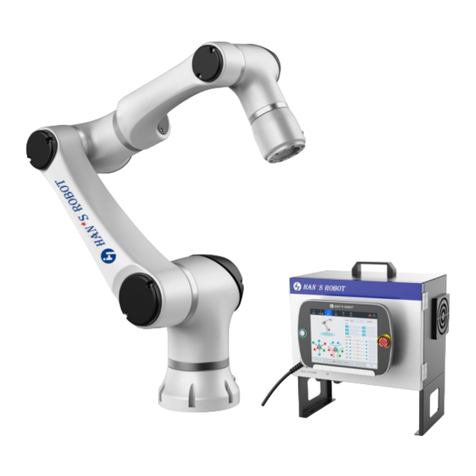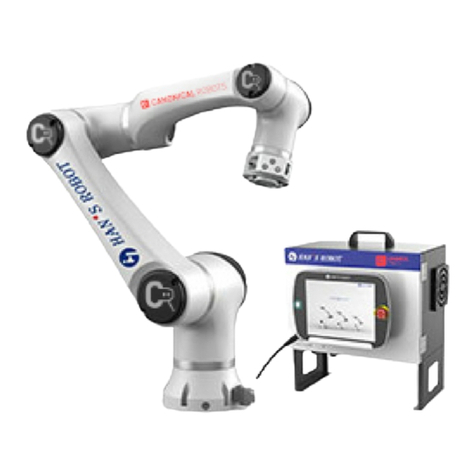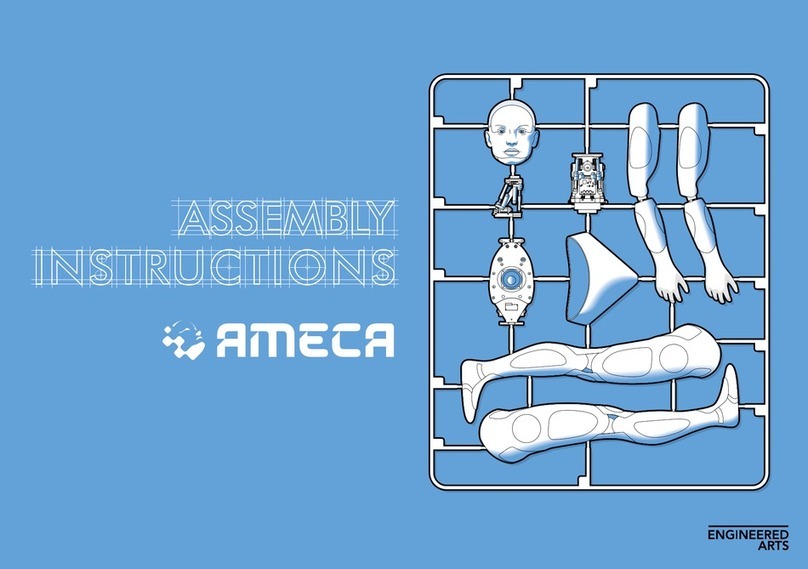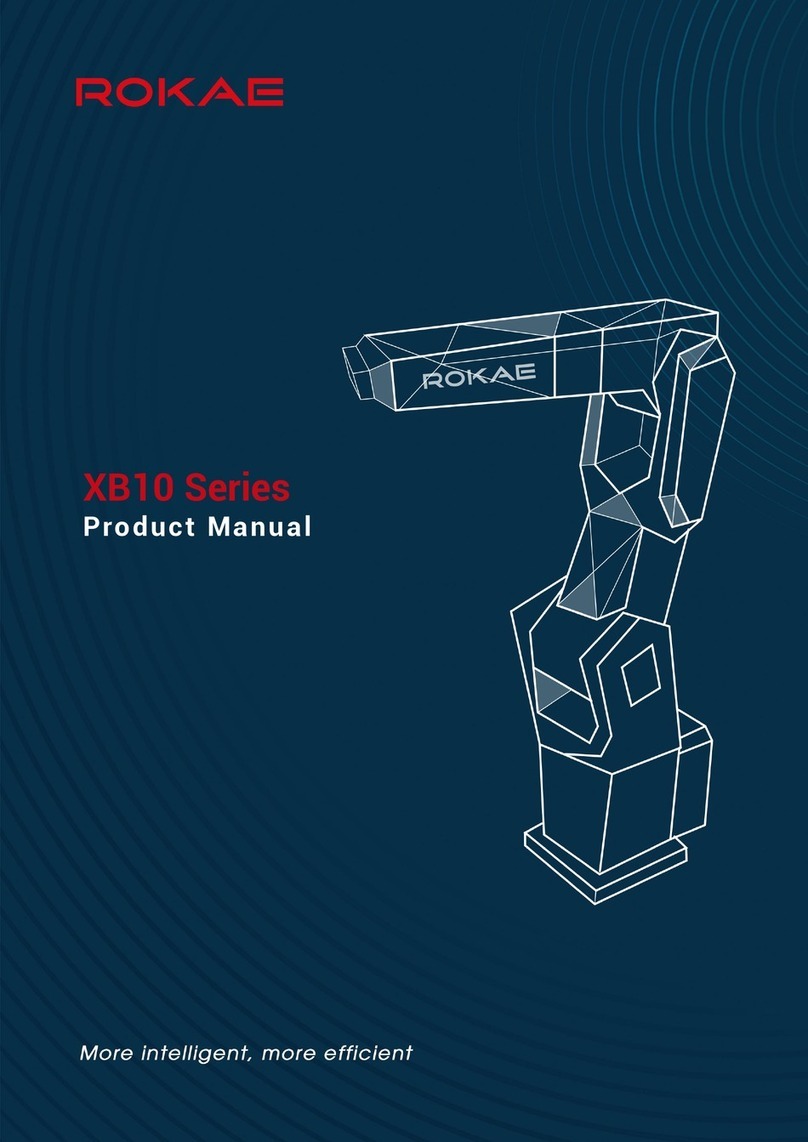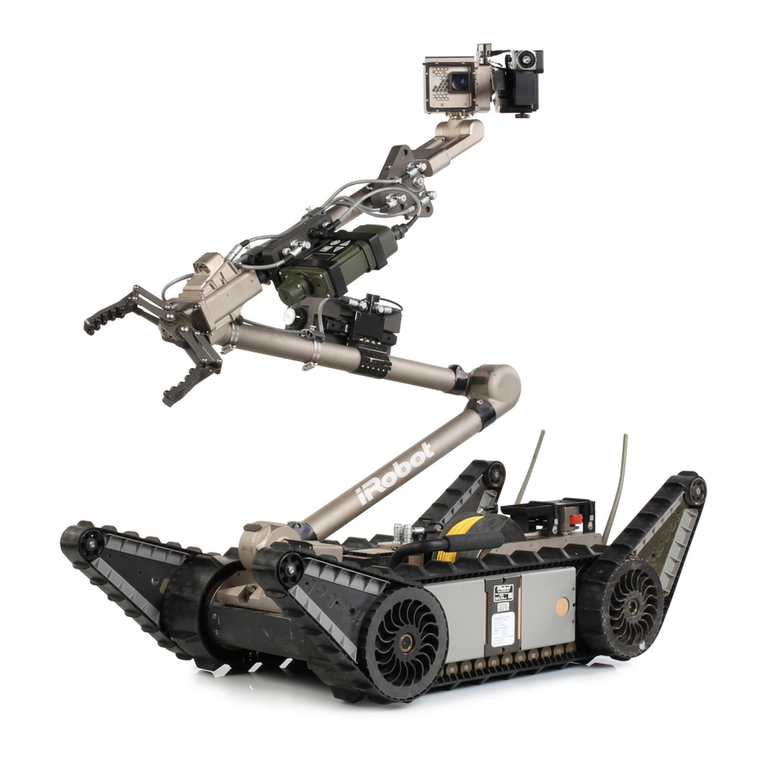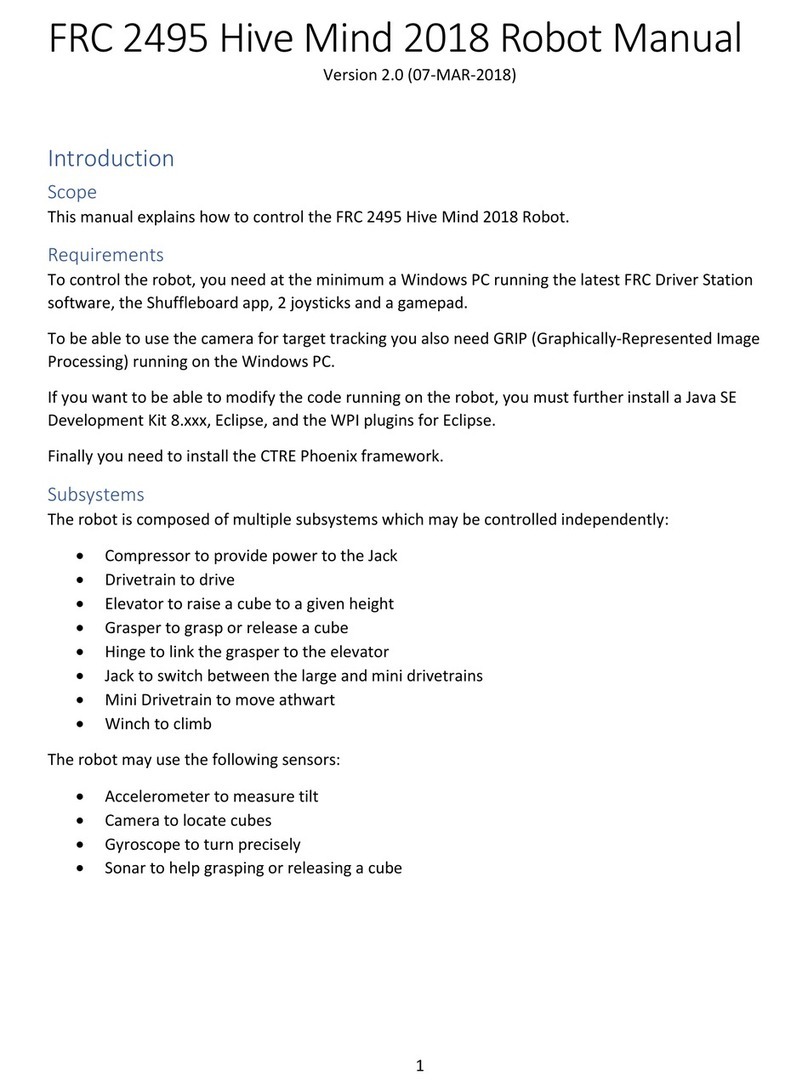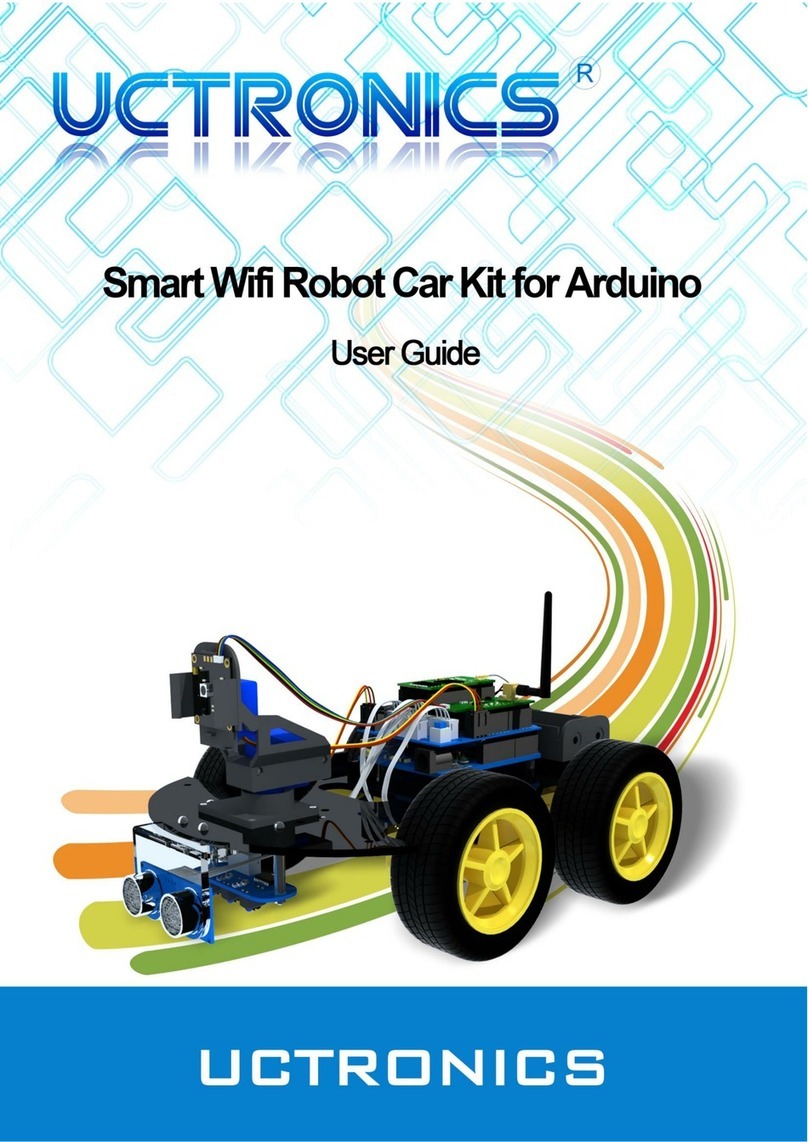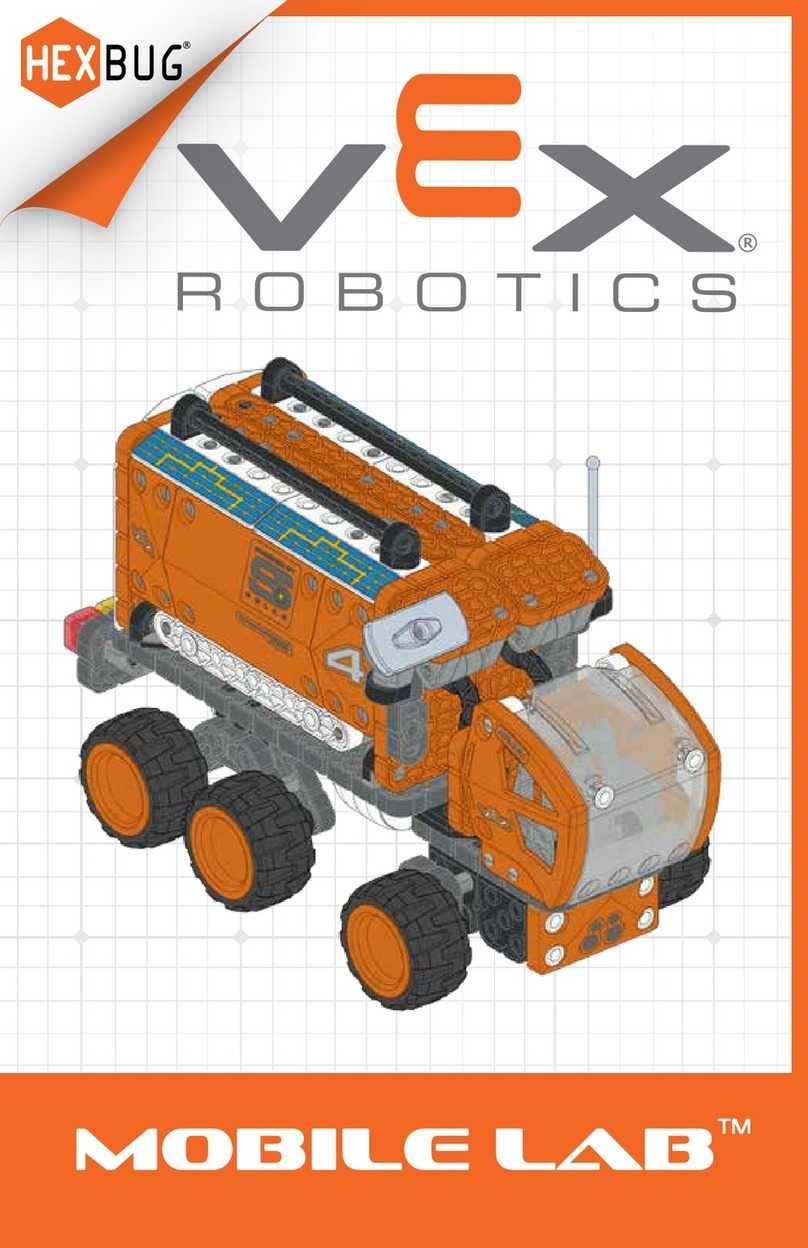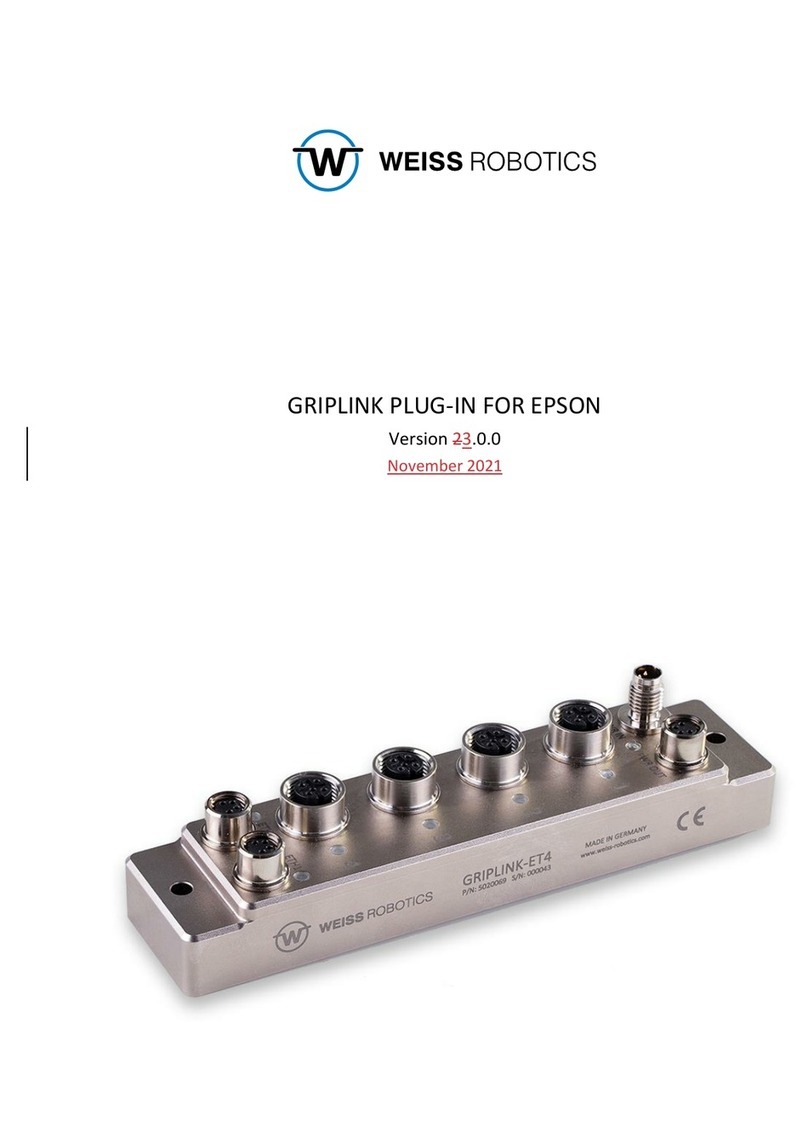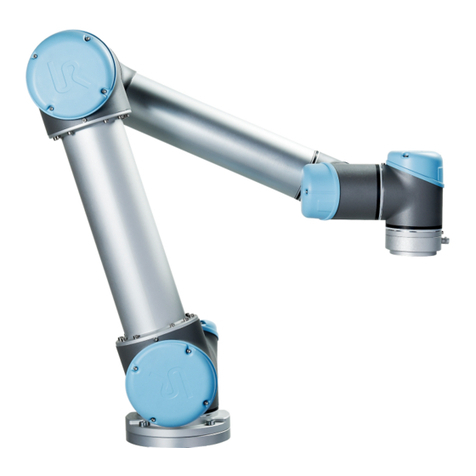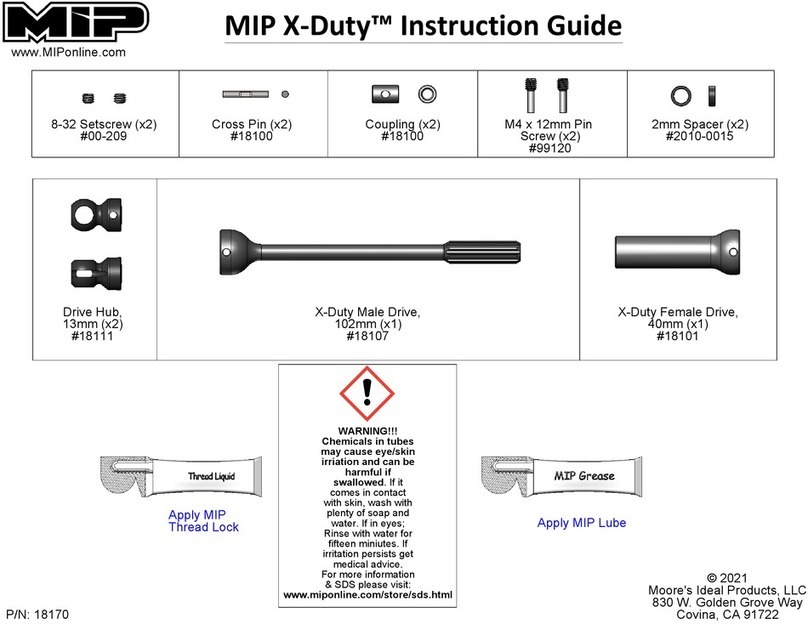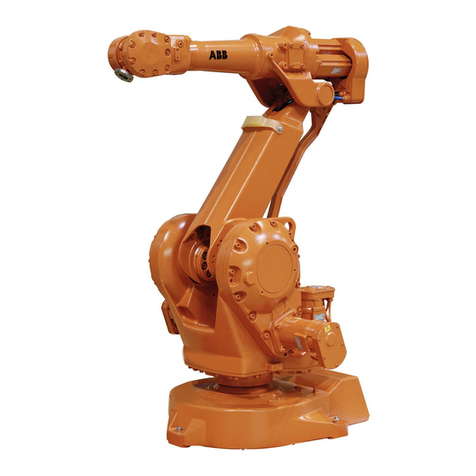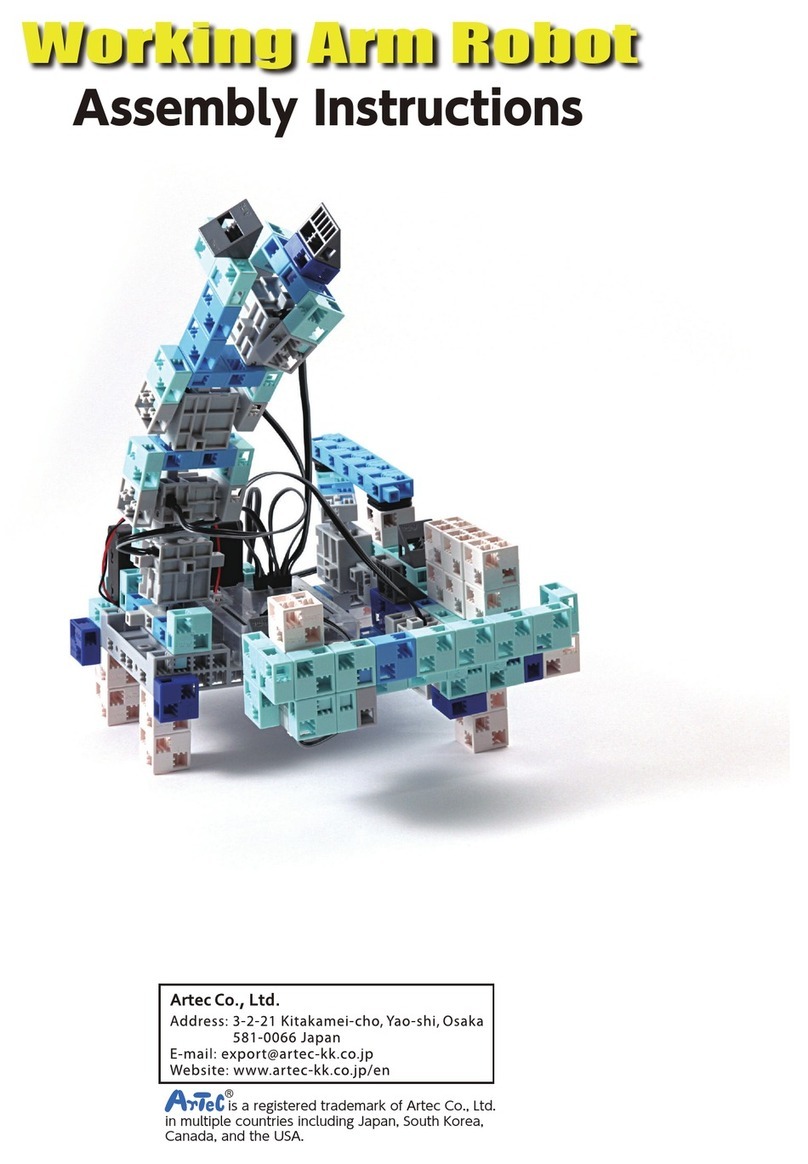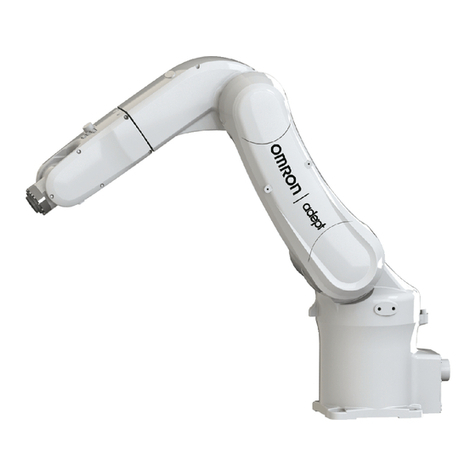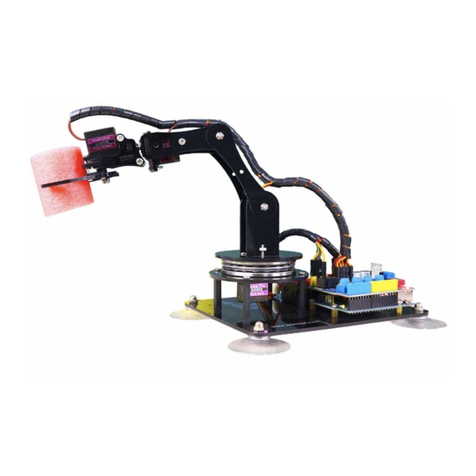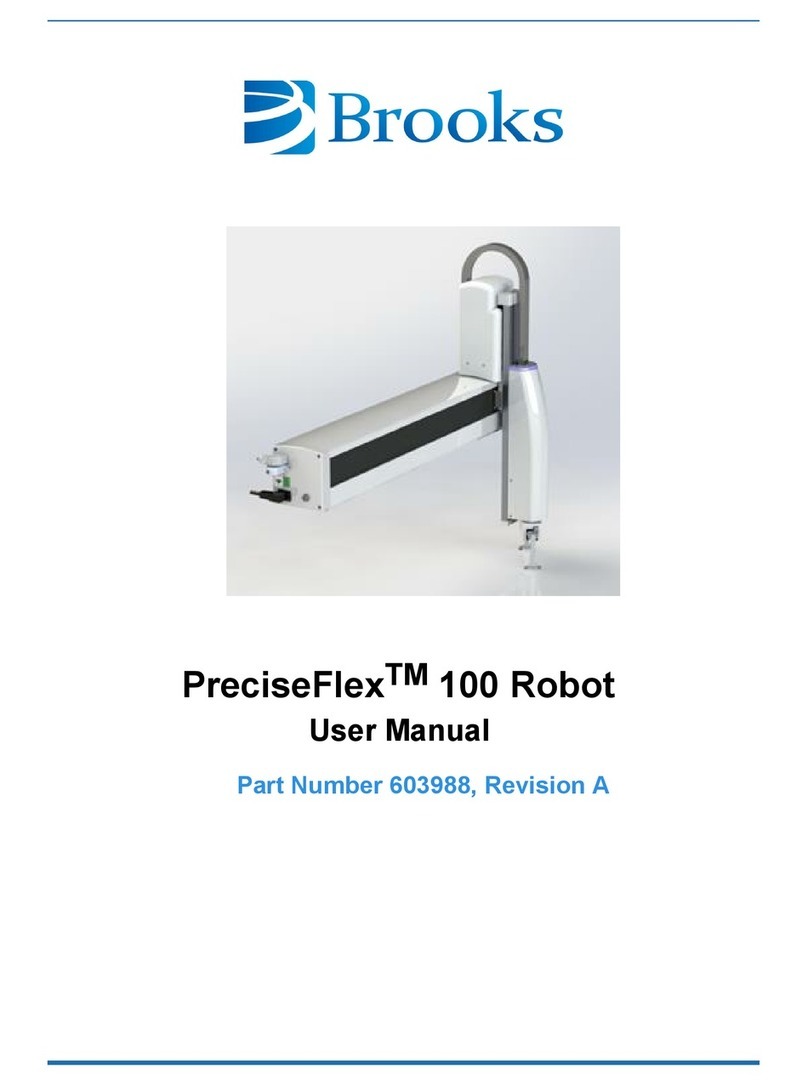Han's Robot Elfin Series Manual

Collaborative Robot Elfin Series
Hardware Installation
(E03/E05/E10)
V2.0.0

II
Introduction
How to Use This Manual
This manual is intended for operators of Elfin robots, who should have some
electrical and programming knowledge. The manual will provide instructions for Elfin
operators from the following ways:
Safety: The operator should keep all safety instructions in mind.
Mechanical Installation: The operator should follow the instructions
when installing the robot.
Electrical interface: Open ports of Elfin are introduced for the
convenience of secondary development.
Software Control: It can guide the operator to install software and run
the robot.
Security Configuration: It introduces the basic safety settings.
Technical Support
ShenzhenHan'sRobotCo.,Ltdwillprovideyouwithlong‐termtechnicalservices. If
you have any technical problems or other needs during using our robot, you are welcome
to visit our company website: www.hansrobot.com, or directly contact our technical
engineers.
Contact Information
Company Address: 5F, Block B, Han's Innovation Mansions, No. 9018 Beihuan
Boulevard, High‐tech Park, Nanshan District, Shenzhen, China
Factory Address: 4F, Building 4, Han's Laser Industrial Park, No.128 Chongqing Road,
Fuyong Town, Baoan District, Shenzhen, China
Mobile: +86 75526983668 Fax: +86 7552698278

I
Contents
INTRODUCTION........................................................................................................... II
HOW TO USE THIS MANUAL.............................................................................................II
TECHNICAL SUPPORT........................................................................................................ II
CONTACT INFORMATION................................................................................................... II
CHAPTER 1 PRODUCT INTRODUCTION...................................................................1
1.1 INTRODUCTION TO COLLABORATIVE ROBOT ELFIN SERIES...........................................12
1.2 LIST OF PARTS.......................................................................................................12
1.3 ROBOT BODY........................................................................................................13
1.3.1 NAME OF EACH PART................................................................................13
1.3.2 SIZE AND SPECIFICATION(E03)..............................................................14
1.3.3 SIZE AND SPECIFICATION(E05).......................................................... 15
1.3.4 SIZE AND SPECIFICATION(E10)..............................................................16
1.3.5 ROBOT WORKING SPACE........................................................................... 16
1.3.6 TOOL PAYLOAD RANGE.............................................................................. 18
1.4 ELECTRIC CONTROL BOX.........................................................................................20
CHAPTER 2 SAFETY ISSUE..................................................... 错误!未定义书签。
2.1 WARNING SIGNS..................................................................错误!未定义书签。
2.2 GENERAL SAFETY REMINDER................................................. 错误!未定义书签。
2.3 OTHER POTENTIAL RISKS.......................................................错误!未定义书签。
2.4 RISK ASSESSMENT................................................................错误!未定义书签。
2.5 STOP MECHA NISM ................................................................错误!未定义书签。
2.6 REPAIR AND MAINTENANCE INSTRUCTIONS............................. 错误!未定义书签。
CHAPTER 3 MECHANICAL INSTALLATION.............................................................22
3.1 OPEN THE CARTON................................................................................................22
3.2 INSTALLATION ENVIRONMENT REQUIREMENTS..........................................................23
3.3 INSTALLATION SPACE............................................................................................. 23

II
3.4 FIXING THE ROBOT(E03/E05 ROBOT).............................................................. 24
3.5 INSTALLING TOOLS TO THE TERMINAL OF ROBOT(E03/E05 ROBOT)..................... 25
3.6 FIXING THE ROBOT(E10 ROBOT)...................................................................... 26
3.7 INSTALLING TOOLS TO THE TERMINAL OF ROBOT(E10 ROBOT)............................. 27
CHAPTER 4 QUALITY WARRANTY......................................................................... 28
4.1 PRODUCT QUALITY WARRANTY.............................................................................. 28
4.2 DISCLAIMER..........................................................................................................29
CHAPTER 5 APPENDIX........................................................................................ 30
5.1 TECHNICAL SPECIFICATIONS.................................................................................... 30
5.2 LIMITING SECURITY‐RELATED FUNCTIONS.................................................................36
5.3 ELECTRICAL SAFETY SPECIFICATIONS........................................................................ 36

1
Chapter 1 Safety Precautions
1.1 Warning sign
The following different levels of safety signs will appear in this manual:
Danger:
Failure to follow instructions can result in death or serious injury.。
Warning:
Failure to follow instructions can result in personal injury or serious
damage to equipment。
Caution:
Failure to follow instructions can cause equipment damage。

2
1.2 Safety
Introduction
This chapter introduces the safety principles and specifications that should be
followed when operating the robot or robot system. Integrators and users must read this
manual carefully, and the contents with warning signs need to be mastered and strictly
followed. Because the robot system is complex and dangerous, users need to fully
understand the risks of operation and strictly abide by and implement the specifications
and requirements in this manual. Users and integrators need to have sufficient safety
awareness and comply with the industrial robot safety standard ISO 10218.
Elfin robots are equipped with a variety of built‐in safety functions and safety I/O,
digital and analog control signals to and from the electrical interface, used to connect
other machines and additional protection devices. Each safety function and I/O are
constructed in accordance with EN ISO13849‐1:2008. The d performance level (Pld) of the
three types of structures is used to understand the configuration of safetyfunctions,
inputs, and outputs in the user interface. About the connection of safety equipment and
I/O.
Caution:
1. The use and configuration of safety functions and interfaces must followtherisk
assessment procedures of each robot application.
2. If the robot finds a fault or violation in the safety system (for example, a line in the
emergency stop circuit is cut off or a safety limit violation occurs), the robot will
immediately cut off the power and stop.
3. The stop time should be considered as part of the application risk assessment.
Danger:
1. The difference between the safety configuration parameters used and therisk
assessment can lead to risks that cannot be reasonably eliminated or risks that
cannot be sufficiently reduced.
2. Make sure that the tool and jaws are properly connected to avoid danger if the
power supply is interrupted.
3. The end effector is not protected by the security system of Shenzhen Han Robot
Co., Ltd. End effector and/or connection cable function is not monitored.

3
Safety Precautions
Overview
This manual contains safety measures to protect users and prevent damage tothe
machine. Users need to read all relevant descriptions in the manual and be fully familiar
with security matters. In this manual, we try to describe various situations, but due to too
many possibilities, it is impossible to record all situations that cannot or cannot be done.
usage notice
The following basic information needs to be understood and followed when starting
the robot or robot system for the first time. Other safety‐related information is introduced
in other parts of the manual. However, it is impossible to cover everything.Inpractical
applications, specific problems need to be analyzed.
Installation operation:
1. Be sure to install the robot and all electrical equipment in
accordance with the requirements and specifications in this manual.
2. Before using the robot for the first time and putting it into
production, preliminary testing and inspection of the robot and its
protective system are required.
3. Before starting the system and equipment for the first time, you
must check whether the equipment and system are complete, whether the
operation is safe, and whether any damage is detected. During this
inspection, it is necessary to observe whether it complies with the effective
safety production regulations of the country or region, and all safety
functions must be tested.
4. The user must check and ensure that all safety parameters and user
programs are correct and that all safety functions are working properly. A
person qualified to operate the robot is required to check each safety
function. The robot can only be started after passing a comprehensive and
careful safety test and reaching a safety level.
5. A professional is required to install and debug the robot in
accordance with the installation standards.
6. After the robot installation and construction are completed, a
comprehensive risk assessment needs to be conducted again and the
documentation kept.

4
7. The security parameters are set and changed by authorized
personnel, and passwords or isolation measures are used to prevent
unauthorized personnel from changing or setting security parameters.
After the safety factor is modified, the relevant safety functions need to be
analyzed.
8. In the event of an accident or abnormal operation of the robot, you
can press the emergency stop switch to stop the robot.
9. Elfin series robot joint modules are equipped with brakes to
maintain the robot's posture when the power is turned off. Do not
artificially break the power supply system frequently. It is recommended
that the time interval for switching on and off each time should be greater
than 10s.
10. Elfin series robots have a collision detection function. When the
external force of the robot is powered on and exceeds the normal force
range set by the user's safety, the robot will automatically stop to prevent
the robot or the operator from collision and injury. This function is specially
set for the safety of human‐machine collaborative work of Elfin series
robots, but requires that the robot system must be within the normal
operating range and use the Elfin series control cabinet. If the user
develops the controller himself, the robot does not have the above
functions. The resulting dangerous consequences are borne by the users
themselves.

1
Operation and mechanical heating
1. The robot body and control cabinet will generate heat during
operation. Robot is
Do not operate or touch the robot while working or just after stopping
work.
2. Turn off the power and wait an hour for the robot to cool down.
3. Never put your fingers into the hot place of the control cabinet.
Usage
1. Make sure that the robot's arms and tools are installed correctly
and safely.
2. Make sure that the robot arm has enough space to move freely.
3. If the robot is damaged, do not use it. Please contact the technical
support personnel of Shenzhen Han Robot Co., Ltd. in time.
4. Do not connect the safety equipment to the normal I/O interface,
only use the safety type I/O interface.
5. Make sure to set the correct installation settings (such as the
installation angle of the robot body, the weight in TCP, TCP tool coordinates,
safety configuration). Save and load the installation file into the program.
6. Tools and obstacles must not have sharp corners or twisted points.
Make sure everyone's head and face are outside the reach of the robot.
7. Pay attention to the movement of the robot when using the teach
pendant.
8. Any impact will release a lot of kinetic energy, which is much higher
than at high speed and high payload.
9. Connecting different machines may increase the danger or cause
new dangers. Always conduct a comprehensive risk assessment of the
entire installation. When different safety and emergency shutdown
performance levels are required, always choose the highest performance
level. Always read and understand the manuals for all equipment used in
the installation.
10. Never modify the robot. Changes to the robot may cause

2
unpredictable danger to the integrator. The authorization and
reorganization of robots must be in accordance with the latest version of all
relevant service manuals. If the robot is changed or modified in any way,
Shenzhen Han Robot Co., Ltd. refuses to take all responsibility.
Application environment
1. When the robot is connected or working together with a machine
that can cause damage to the robot, it is strongly recommended to check
all the robot functions and robot programs separately. It is recommended
to use temporary waypoints outside of other mechanical workspaces to
detect robot programs.
2. Shenzhen Han Robot Co., Ltd. shall not be liable for any damage or
personal injury caused to the robot due to errors in the script or improper
operation of the robot.
3. Do not expose the robot to permanent magnetic fields at all times.
Strong magnetic field can damage the robot。
Operator safety
When operating the robot system, you must first ensure the safety of
the workers. The general precautions are listed below. Please take
appropriate measures to ensure the safety of the workers.
Each operator using the robot system should receive training through
the training course sponsored by Shenzhen Han Robot Co., Ltd. The user
needs to ensure that he fully masters the safe and standardized operation
process and has the qualification for robot operation. For details of the
training, please inquire with our company, see the official website for
contact information : http://www.hansrobot.com
2. Please don't wear loose clothes and jewelry when working with the
robot system. When operating the robot, make sure your long hair is tied
behind your head.
3. During the operation of the equipment, even if the robot seems to
have stopped, it may be because the robot is waiting for the start signal

3
and is in a state of about to move. Even in this state, the robot should be
regarded as being in motion.
4.Linesshouldbedrawnonthefloortomarktherangeofmotionof
the robot, so that the operator understands the range of motion of the
robot including holding tools (manipulators, tools, etc.).
5. Make sure to establish safety measures (for example, guardrails,
ropes, or protective screens) near the robot operation area to protect the
operator and surrounding people. Locks should be set according to the
needs, so that the person in charge of the operation can not access the
robot power supply.
6. When using the operation panel and the teaching pendant, because
wearing gloves may cause operational errors, be sure to take off the gloves
before working.
7. In an emergency or abnormal situation such as a person being
caught or surrounded by a robot, push or pull the robot arm with force (at
least500N)toforcethejointtomove.Manuallymovingtherobotarm
without electric drive is limited to emergency situations and may damage
the joints.。
1.3 Responsibilities and specifications
The Elfin series of robots can be combined with other equipment to form a complete
machine, which is not complete in itself. Therefore, the information in this manual does
not include how to fully design, install, and operate a complete robot, nor does it include
all the possibility of affecting the safety of the peripheral equipment of this complete
system. The safety of a complete robot installation depends on how the robotis
integrated. Integrators need to follow the laws and regulations of the hostcountryand
safety regulations and standards to conduct a risk assessment of the designand
installation of the complete system. Risk assessment is one of the most important tasks
that integrators must complete. Integrators can refer to the following standards to
perform the risk assessment process. Risk assessment is one of the most important tasks
that integrators must complete. Integrators can refer to the following standards to

4
perform the risk assessment process.
ISO 12100:2010 Safety of machinery‐General design principles‐Risk assessment and
risk reduction.
ISO 10218‐2:2011 Robots and robotic equipment‐Safety requirements‐Part2:
Industrial robot systems and integration.
RIA TR R15.306‐2014 Technical Report on Industrial Robots and Robot Systems‐Safety
requirements, mission‐based risk assessment methods.
ANSI B11.0‐2010 Safety of machinery; general requirements and risk assessment.
The integrator of Elfin Robot needs to perform but not limited to the following
responsibilities:
Comprehensive risk assessment of complete robot systems;
Confirm that the design and installation of the entire system
is accurate;
Provide training to users and staff;
Create a complete system of operating specifications and clearly
explain the use process;
Establish appropriate security measures;
Use appropriate methods during final installation to
eliminate hazards or minimize all hazards to an acceptable
level;
Communicate residual risks to end users;
Mark the integrator's logo and contact information on the
robot;
Archive related technical documents。
For access to applicable standards and legal guidelines, please visit
www.hansrobot.com
All safety information contained in this manual should not be regarded
as a guarantee of Shenzhen Han Robot Co., Ltd. Even if all safety
instructions are followed, personal injury or equipment damage caused by
operators may still occur.
Shenzhen Han Robot Co., Ltd. is committed to continuously improving
the reliability and performance of the product, and therefore reserves the

5
right to upgrade the product without prior notice. Shenzhen Han Robot Co.,
Ltd. strives to ensure the accuracy and reliability of the contents of this
manual, but is not responsible for any errors or missing information.

6
Hazard identification
The risk assessment should consider all potential contact between the
operator and the robot during normal use and foreseeable misoperation.
The operator's neck, face and head should not be exposed to avoid
touching. Using robots without using peripheral safety guards requires a
risk assessment to determine whether the relevant hazards will constitute
an unacceptable risk, such as
1. The use of sharp end effectors or tool connectors may be
dangerous;
2. It may be dangerous to handle toxic or other harmful substances;
3. The operator's fingers may be caught by the robot base or joints;
4. The danger of being collided by the robot;
5. The danger that the robot or the tool connected to the end is not
fixed in place;
6. Danger caused by impact between the robot payload and a solid
surface.
Integrators must measure such hazards and their associated risk levels
through risk assessment, and determine and implement appropriate
measures to reduce the risk to an acceptable level. Please note that there
may be other major hazards with certain robotic devices.
By combining the inherent safety design measures applied by Elfin
robots with the safety specifications or risk assessments implemented by
integrators and end users, the risks associated with the collaborative
operation of Elfin series robots are reduced to a reasonable and feasible
level as much as possible. This document can be used to communicate any
remaining risks of the robot before installation to the integrator and end
user. If the integrator’s risk assessment determines that there are risks in
its specific application that may pose an unacceptable risk to the user, the
integrator must take appropriate risk reduction measures to eliminate or
minimize these risks until the risk is reduced to an acceptable level until.It
is unsafe to use before taking appropriate risk reduction measures (if
necessary).
If the robot is installed in a non‐cooperative manner (for example,
when using dangerous tools), the risk assessment may infer that the

7
integrator needs to connect additional safety equipment (for example, safe
start‐up equipment) to ensure the safety of personnel and equipment
during their programming.
1.4 Intended use
The following statement of use, when Elfin robots are only used for
general industrial equipment, such as operating or fixing tools, equipment,
processing or transferring parts, products. Elfin robots are only allowedto
be used under specified environmental conditions. For specific information
about the operating environment and operating conditions, please refer to
the appendix.
The Elfin robot has a special safety level feature, which can be used for
collaborative operation, that is, it is used without peripheral safety
protection devices, but only when there is no risk after risk assessment,
that is, without any safety protection devices and field induction devices
Under the premise of, the expected or accidental contact between the staff
and the Elfin robot or its end effector or components will not constitute an
unacceptable risk, and the expected or accidental contact with other
objects (tools, equipment, surfaces, etc.) in the work area Does not pose an
unacceptable risk.
Robot controllers and robots are limited to the use of general
industrial equipment and cannot be used in applications that violate the
intended use.
Prohibited uses include but are not limited to the following:
Used in flammable and explosive hazardous environments;
Deviceformovingorcarryingpeopleorotheranimals
;
Used in medical equipment and other devices related to human life;
For devices that have a significant impact on sociality and publicity;
Used in vibration environment of vehicles, ships, etc.;
Used for climbing tools。

8
1.5 Emergency handling
Emergency stop device
Pressing the emergency stop button will stop all movement of the
robot. Emergency shutdown cannot be used as a risk reduction measure,
but it can be used as a secondary protection device. If multiple emergency
stop buttons must be connected, they must be included in the risk
assessment of the robot application. The emergency stop button meets the
requirements of IEC 60947‐5‐5.
Elfin series robots are equipped with an emergency stop button on the
control cabinet and the teach pendant. This button must be pressed in a
dangerous or emergency situation, as shown in the following figure. The
control cabinet is equipped with an external emergency stop button port,
which can be used by integrators or users according to the actual situation.
Tools or equipment connected to the terminal must be integrated into
the emergency stop circuit of the system if they pose a potential threat.
Failure to observe this warning may result in death, serious personal injury,
or significant property damage.
Recovery from emergency
All emergency stop devices in the form of keys have a "lock" function.
This "lock" must be opened to end the emergency stop state of the device.
Turn the emergency stop button to open the "lock".
Recovering from the emergency stop state is a simple but very
important step, this step can only be operated after ensuring that the
danger of the robot system is completely eliminated.
Force emergency movement of joints
In rare cases, it may be necessary to move one or more robot joints in
an emergency situation where the power supply of the robot fails or does
not want to use the power supply. This can be forced by the following
methods:
Forced reverse drive: force (at least 500N) to push or
pull the robot arm to force the joint to move。

9
Forced manual movement of the robot arm is limited to
emergency situations and may damage the joints.
Robot safety protection (strong torque)
The robot body has a strong security protection function. When the
robot body is powered on and stationary, when an operator or other object
accidentally touches the robot body and the collision force exceeds the
safety threshold, the robot body will passively move in the direction of the
collision force. This function can ensure that when an operator or other
object collides with the robot body, it can reduce the damage to the
personnel, other objects and the robot body.
This function can reduce the collision damage, for other purposes
need to conduct a risk assessment. Security emergency handling.
1.6 Handling and precautions
When the robot is hoisted, the moving parts should take appropriate
measures to locate, so as not to cause unexpected movement during
hoisting and transportation, causing harm.
When packaging and transporting, it should be packed according to
the packaging standards, and the required marks should be marked on the
outside of the box. During transportation, it is necessary to ensure that the
robot is stable and that it is kept in place. The control cabinet should be
lifted with a handle. When moving the robot to the installation position
from the packaging material of the robot, hold the robot until all bolts of
the robot base are tightened.
After fixing, power on the robot, and use the robot drag teaching
function to adjust the robot posture to a suitable position. Keep the
original packaging after transportation. Keep packaging materials in a dry
place in case you need to repack and move the robot in the future.
Make sure that your back or other body parts are not
overloaded when lifting the device。
All regional and national guidelines should be followed.
Shenzhen Han Robot Co., Ltd. is not responsible for the damage

10
caused during the transportation of equipment.
Make sure to strictly follow the installation instructions in the
manual when installing the robot.
1.7 Other potential risks
Please note that there may be other major hazards with certain
robotic devices:
Fingers are caught between the robot feet and the base.
Fingers are caught between the forearm and the forearm.
Sharp edges and sharp points on the tool or tool connector
pierce the skin
Sharp edges and sharp points on obstacles near the robot
trajectory puncture the skin.
Injured by a robot collision.
Sprains or fractures due to the impact between the robot's
payload and a solid surface.
Consequences due to loose bolts used to fix the robot arm or
tool.
Items fall from the tool, for example due to inadequate
clamping or power failure.
Operationerrorsduetodifferentemergencystopbuttonson
different machines.
1.8 Maintenance instructions
Maintenance and repair work must strictly follow all safety instructions in this manual.
Danger:
Remove the main input cable from the bottom of the electrical box to
ensure that it is completely powered off. Disconnect other energy sources
connected to the robot arm or electrical control box. Take necessary precautions

11
to prevent others from reconnecting the system energy during maintenance.
Please check the ground connection before restarting the system.
Please observe ESD regulations when disassembling the robot arm or
electrical control box.
Avoid splitting the power supply system in the electric control box.
After the electric control box is closed, its power supply system can still
retain high voltage (up to 600V) for several hours.
Avoid water or dust entering the robot arm or electric control box.
After maintenance and repair, a check must be carried out to ensure
the safety level required by the service. When verifying, you must
abide by effective national or local safety laws and regulations. At
the same time, it should be checked whether all safety functions are
normal.

12
Chapter 2 Product Introduction
2.1 Introduction to Collaborative Robot Elfin Series
Elfin robot is a new type of human‐machine collaborative six‐axis robot. Its overall
design is lightweight, modular, compact and beautiful, and it can flexibly accommodate to
all kinds of complicated and varying industrial production environments.
2.2 List of Parts
Robot Robot body ×1
End connection line ×1
Electric control box
Electric control box ×1
Power cable line ×1
Connecting cable line ×1
Teach pendant Teach pendant ×1
Instructions Stored in USB flash disk ×1
Other manuals for Elfin Series
1
This manual suits for next models
3
Table of contents
Other Han's Robot Robotics manuals
